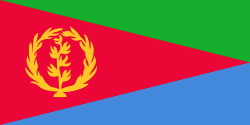Anseba Region (Anseba Region)
As of 2005, the region had a population of 549,000 compared to a population of 484,200 in 2001. The net growth rate was 11.80 per cent. The total area of the province was 23200.00 km2 and the density was 23.66 persons per km2.
The capital of Anseba region is Keren and it has an area of about 23,000 km2. It is named after the Anseba River around which the region is situated. The river begins in the central Eritrean highland plateau, in the suburbs northwest of the capital Asmara. It then descends northwards into the northwestern lowlands, traversing the mountains of Rora Habab and Sahel before joining the Barka River near the border with Sudan. Other towns in this region include Halhal. The region borders Gash-Barka to the south, the Maekel (Central) region to the south-east, the Northern Red Sea Region to the east and north, and the Sudan to the west. The topography of the region has highland plateau, which are cooler than the regions around the coastal plains. There are two rainy seasons, the heavier one during summer and the lighter one during spring. The climate and geography of the region along with other regions of Eritrea is similar to the one of Ethiopia. The average elevation in the region is around 1800 m to 2100 m. The hottest month is May recording temperatures up to 30 °C, while the coldest month is December to February when it reaches freezing temperature. The region received around 508 mm of rainfall and the soil is conducive for agriculture.
There are a number of flora and fauna species within this region. Notably this was historic habitat for the endangered painted hunting dog (Lycaon pictus), a canid which is now thought to be extirpated from the region. Eritrea as a whole was extensively forested as recently as 1900. However, at present the total forest cover of Eritrea is less than one percent.
Map - Anseba Region (Anseba Region)
Map
Country - Eritrea
 |
 |
| Flag of Eritrea | |
Human remains found in Eritrea have been dated to 1 million years old and anthropological research indicates that the area may contain significant records related to the evolution of humans. Contemporary Eritrea is a multi-ethnic country with nine recognised ethnic groups. Nine different languages are spoken by the nine recognised ethnic groups, the most widely spoken language being Tigrinya, the others being Tigre, Saho, Kunama, Nara, Afar, Beja, Bilen and Arabic. Tigrinya, Arabic, and English serve as the three working languages. Most residents speak languages from the Afroasiatic family, either of the Ethiopian Semitic languages or Cushitic branches. Among these communities, the Tigrinyas make up about 55% of the population, with the Tigre people constituting around 30% of inhabitants. In addition, there are several Nilo-Saharan-speaking Nilotic ethnic groups. Most people in the country adhere to Christianity or Islam, with a small minority adhering to traditional faiths.
Currency / Language
| ISO | Currency | Symbol | Significant figures |
|---|---|---|---|
| ERN | Eritrean nakfa | Nfk | 2 |
| ISO | Language |
|---|---|
| AA | Afar language |
| AR | Arabic language |
| TI | Tigrinya language |















